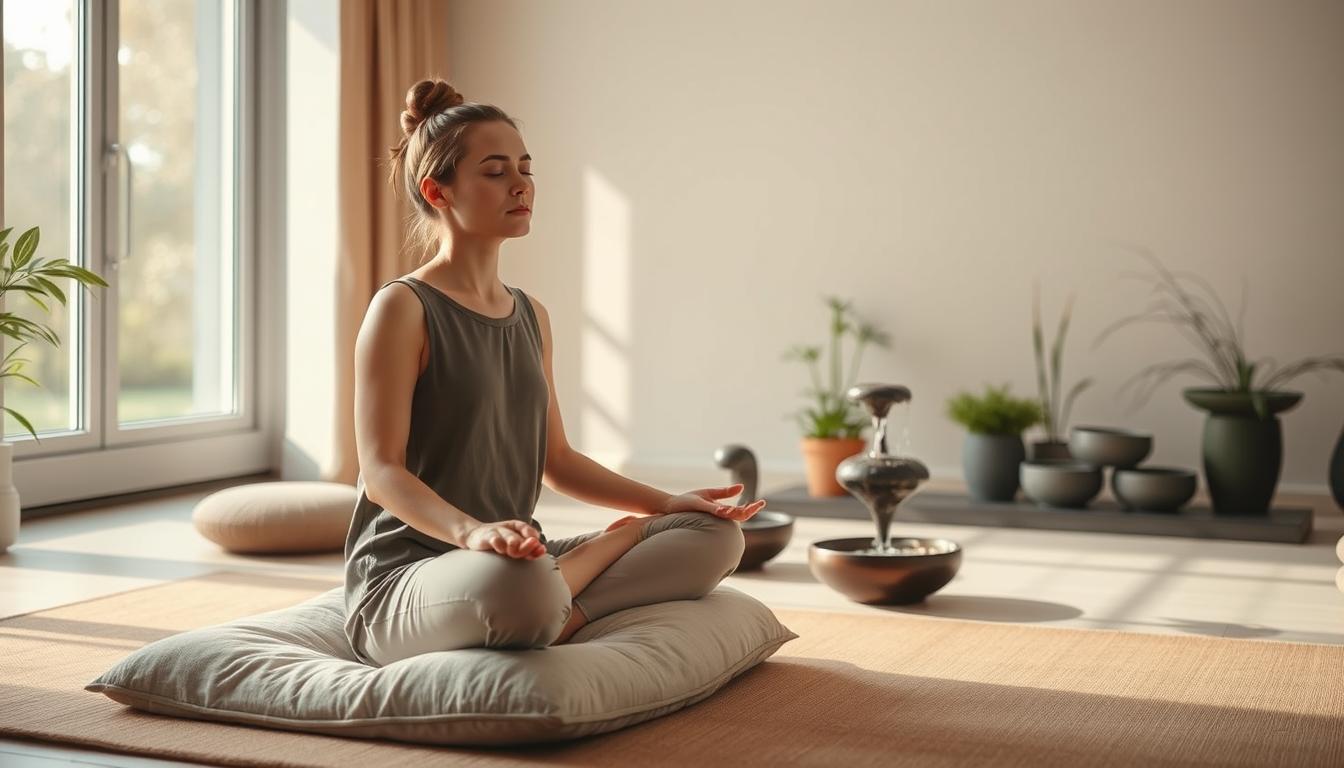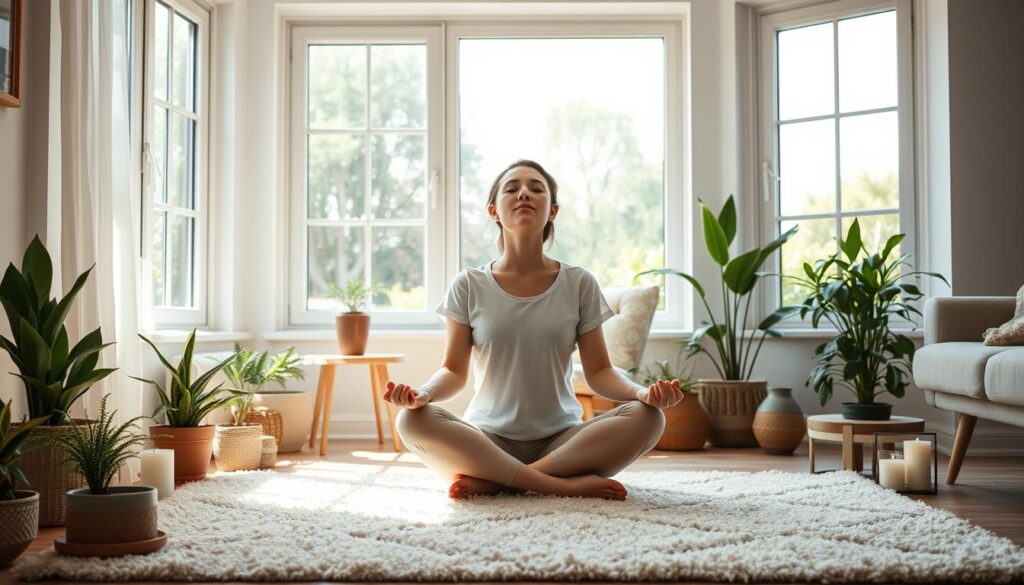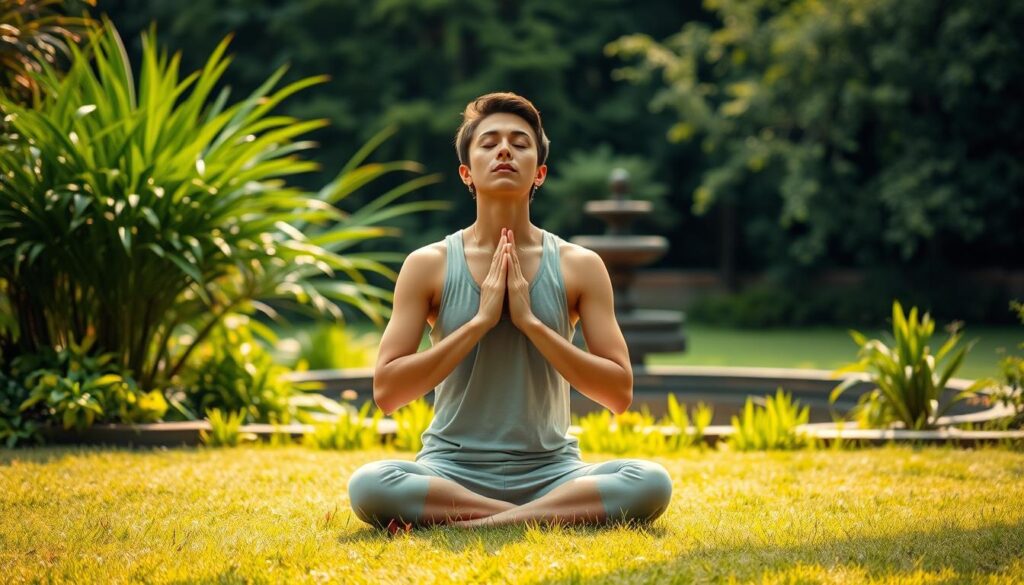Grounding for Stress Relief: Techniques to Calm Your Mind
Do you often feel overwhelmed by daily life? You’re not alone. Stress and anxiety can make…

Do you often feel overwhelmed by daily life? You’re not alone. Stress and anxiety can make it hard to stay in the moment. That’s where mindfulness practices come in – they’re powerful tools to calm your mind and reduce stress.
By adding simple stress management techniques to your day, you can handle stress better. Grounding techniques help you stay in the present. They let you forget worries about the past or future.
Key Takeaways
- Grounding techniques can help reduce stress and anxiety.
- Mindfulness practices promote overall well-being.
- Simple stress management techniques can be incorporated into daily life.
- Grounding helps you focus on the present moment.
- Regular practice can lead to improved mental health.
What is Grounding and How Does It Help?
Grounding is a simple yet effective method to help with anxiety, stress, and PTSD. It brings your focus to the present moment. You use your senses to ground yourself, distracting you from stressful thoughts and emotions.
Understanding the Concept of Grounding
Grounding techniques help you focus on the present moment. You might notice the sensation of your feet on the ground or the sounds around you. By focusing on these things, you can calm your mind and reduce anxiety and stress.
The idea behind grounding is to be fully present. This helps you stop worrying about the past or future. It’s very helpful for those with anxiety, as it breaks the cycle of negative thoughts.
Benefits of Grounding for Mental Well-Being
Grounding has many benefits for mental well-being. It reduces symptoms of anxiety and stress, improving mental health. Regular practice also helps with emotional regulation, making it easier to handle difficult emotions.
Grounding is also useful for managing PTSD symptoms. It helps by focusing on the present, reducing the impact of flashbacks and other symptoms. This improves quality of life.
Scientific Research Supporting Grounding Techniques
Research shows grounding techniques are effective in reducing anxiety and depression symptoms. Studies have found they decrease cortisol levels, heart rate, and blood pressure. These are all signs of stress.
A study in the Journal of Alternative and Complementary Medicine found grounding reduced anxiety symptoms and improved sleep. These findings highlight grounding’s potential as a complementary therapy for mental health.
Simple Grounding Techniques for Everyday Use
We’ve gathered simple ways to handle stress. Grounding techniques help you stay in the moment. They reduce anxiety and stress. Adding these to your day can make you feel calmer and more at peace.
5-4-3-2-1 Grounding Exercise
The 5-4-3-2-1 exercise is easy yet effective. It makes you focus on what’s around you. Here’s how to do it:
- Notice 5 things you see.
- Acknowledge 4 things you can touch or feel.
- Identify 3 things you hear.
- Recognize 2 things you smell.
- Take 1 deep breath, focusing on it.
This exercise helps you feel more grounded and calm. It lets go of anxiety and stress.
Breathing Techniques for Grounding
Breathing techniques are powerful for grounding. When stressed, our breathing gets shallow. Slow, deep breaths calm our nervous system. Try breathing in for four counts, holding for four, and exhaling for four. This can be done anywhere, anytime, helping manage stress.
“The breath is the bridge between the body and the mind.”
Using Nature for Effective Grounding
Being in nature grounds you naturally. Being outdoors, surrounded by nature, calms you. Take a walk in a park, sit by a river, or garden. Connecting with nature makes you feel grounded and less stressed.
Using these simple techniques daily can help manage stress and anxiety. This leads to a more balanced and peaceful life.
Grounding Exercises You Can Try at Home
Make your home a peaceful place with these grounding techniques. Grounding helps you deal with stress and anxiety by focusing on now. Adding these practices to your daily life can improve your mental health and teach you how to handle stress better.
Mindfulness Meditation
Mindfulness meditation is a great way to ground yourself. It’s about noticing your thoughts, feelings, and body without judging. Here’s how to do it at home:
- Find a quiet and comfy spot to sit.
- Close your eyes and breathe deeply.
- Focus on your breath or a simple word to keep your mind on track.
- Start with short sessions (5-10 minutes) and slowly increase the time.
As you meditate, you’ll notice your thoughts and feelings more. This helps you manage stress better.

Journaling Your Thoughts
Journaling is another great way to ground yourself at home. Writing down your thoughts and feelings helps you process and understand them better. Here’s how to start journaling:
- Get a special notebook for journaling.
- Make time each day to write.
- Write freely, without worrying about spelling or grammar.
- Look back at your entries to see patterns or areas to work on.
Journaling can help you release emotions and see life more positively.
Visualization Techniques
Visualization uses your imagination to create a peaceful place in your mind. It’s great for when you’re feeling stressed. Here’s how to visualize:
- Find a quiet and comfy spot to relax.
- Close your eyes and breathe deeply.
- Imagine yourself in a calm place, like a beach or forest.
- Use all your senses to make the image as real as possible.
Practicing visualization regularly can lower anxiety and boost your well-being.
By adding these grounding exercises to your daily routine, you can manage stress better and improve your mental health. Remember, it’s all about being consistent and patient.
How Grounding Affects the Nervous System
Grounding affects the nervous system in a good way. It helps reduce stress by activating the parasympathetic nervous system. This system promotes relaxation.
The Role of the Para-Sympathetic Nervous System
The parasympathetic nervous system is key for relaxation and stress reduction. Grounding activates this system, balancing out stress and anxiety. Experts say it’s vital for our well-being.
Grounding exercises like deep breathing and mindfulness meditation calm the mind and body. Regular practice lowers stress and boosts mental health.
Grounding’s Impact on Stress Levels
Grounding reduces stress by calming the body’s stress response. It keeps you from feeling overly anxious or stressed. Dr. Andrew Weil calls it a powerful stress-reduction technique.
Adding grounding to your daily life can help manage stress better. Simple techniques like walking barefoot or focusing on your breath are great stress relief tips. They work anywhere, anytime.
For the best results, practice grounding often. It builds stress resilience and improves well-being. Grounding is a simple yet effective tool for stress management.
Incorporating Grounding into Your Daily Routine
Grounding is a simple yet powerful technique that can be seamlessly integrated into your daily routine. It can help reduce stress and anxiety, improving your mental well-being.
Setting Aside Time for Grounding
To make grounding a habit, set aside a specific time each day. This could be early in the morning, during your lunch break, or before bed. Consistency is key to experiencing the benefits of grounding.
Mindfulness practices like meditation and deep breathing are effective when done daily. For example, start your day with a 5-minute grounding exercise, focusing on your breath and body sensations.
Creating a Calming Space
Creating a calming space in your home or office can enhance your grounding practice. This space should be quiet, comfortable, and free from distractions. Add elements like candles, plants, or soothing colors to make it more relaxing.
Using your senses is crucial in grounding. In your calming space, engage your senses by listening to calming music, smelling essential oils, or touching a soft blanket.
Using Technology Mindfully
In today’s digital age, technology can be both a blessing and a curse for stress management. While you can’t avoid technology entirely, you can use it more mindfully. Use apps that guide you through relaxation techniques or meditation.
It’s also important to establish boundaries with technology. Turn off notifications during your grounding practice or set aside device-free time. Being mindful of how you use technology can reduce stress and improve your well-being.
Grounding Techniques for Anxiety Management
Anxiety can feel overwhelming. But, using grounding techniques can help calm your mind and body. These methods focus on the present moment, helping you ignore anxious thoughts and feelings.
Using Your Senses to Stay Present
One good way to ground yourself is by focusing on your senses. Notice what you see, hear, smell, taste, and feel right now. For instance, look around and see the colors, textures, and shapes of things. Listen to the sounds, like a fan humming or birds chirping.
Try this exercise: Take a few deep breaths and feel the air move in and out of your body. Then, look around and find five things you can see, four things you can touch, three things you can hear, two things you can smell, and one thing you can taste.
Quick Grounding Techniques for Panic Attacks
When you’re in a panic attack, it’s hard to think straight or remember to use these techniques. But, having quick methods ready can help. Carry a small object, like a stone or fabric, and focus on its texture and weight when you feel anxious.
- Notice the sensation of your feet on the ground.
- Listen to calming music or nature sounds.
- Use a stress ball or fidget toy to release tension.

By using these grounding techniques every day, you can manage anxiety better. This can reduce how often and how intense panic attacks are. Remember, grounding isn’t about avoiding anxiety. It’s about learning to handle it more easily and with more strength.
The Role of Nature in Grounding for Stress Relief
Nature has a big impact on our mental health, bringing calm and peace. When we face daily challenges, nature can help us manage stress and relax.
The Science Behind Nature’s Impact on Mental Health
Studies show that nature can improve our mental health. It can lower anxiety and depression symptoms. A study in the Journal of Environmental Psychology found that nature time boosts mood and reduces stress.
“Being in nature is not just a pleasant experience; it has a profound impact on our mental and emotional well-being.”
The science behind nature’s effect is complex. It involves lower cortisol levels, better mood, and more calm and relaxation.
| Nature Activity | Mental Health Benefit | Stress Relief Outcome |
|---|---|---|
| Walking in the woods | Reduced symptoms of anxiety | Improved mood |
| Gardening | Increased feelings of calm | Reduced stress levels |
| Spending time by water | Improved mood | Enhanced relaxation |
Activities to Connect with Nature
You can easily add nature to your daily life for grounding and stress relief. Try these activities:
- Taking a walk in a nearby park or nature reserve
- Gardening or tending to plants
- Spending time by a body of water, such as a lake or ocean
- Simply sitting outside and enjoying the fresh air and sunshine
By spending time in nature, you can enjoy its many benefits for your mental health and well-being.
Grounding Practices for Teens and Children
Teaching young people to handle stress is key to their emotional health. Grounding techniques are great for teens and kids. They offer ways to deal with anxiety and stress.
Fun Grounding Exercises for Kids
Children can enjoy simple, fun grounding exercises. The “5-4-3-2-1” technique is one example. It asks kids to notice:
- 5 things they can see
- 4 things they can touch
- 3 things they can hear
- 2 things they can smell
- 1 thing they can taste
This activity shifts their focus to the present. Another fun activity is walking barefoot. It connects them with the earth, helping them feel grounded.
| Grounding Exercise | Age Group | Benefits |
|---|---|---|
| 5-4-3-2-1 Technique | 6-12 years | Reduces anxiety, promotes mindfulness |
| Walking Barefoot | 4-10 years | Enhances connection with nature, reduces stress |
| Mindful Coloring | 5-15 years | Fosters creativity, calms the mind |
Encouraging Mindfulness in Adolescents
Teenagers can benefit from more complex mindfulness practices. Encouraging them to try mindfulness meditation is helpful. Guided sessions, through apps or classes, are very beneficial.
“The mind is everything; what you think, you become.” – Buddha
Adding physical activities like yoga or tai chi is also good. These activities help manage stress and improve health and coordination.
Introducing grounding practices to teens and children gives them tools to face life’s challenges. It helps them become more resilient and confident.
Grounding and Spiritual Practices
Grounding is more than just a way to relax; it opens doors to spiritual growth. It helps you connect more deeply with the present moment. This connection can make your spiritual practices more meaningful and calm.
Spiritual Well-Being and Grounding
Grounding is linked to spiritual well-being by strengthening your bond with yourself and nature. This bond can lead to a richer spiritual life. It encourages personal growth and self-awareness.
Grounding can improve your spiritual well-being in several ways:
- It boosts mindfulness and presence.
- It reduces stress and anxiety.
- It deepens your connection to nature.
Meditation and Grounding: A Powerful Combination
Mixing meditation with grounding techniques is very effective. Meditation calms the mind, while grounding keeps you in the present. Together, they create a synergistic effect that boosts relaxation and spiritual growth.
To meditate and ground together, follow these steps:
- Choose a quiet, comfy spot to sit or lie down.
- Close your eyes and breathe deeply, focusing on the breath.
- As you breathe, notice your surroundings, including sights, sounds, and feelings.
By adding grounding to your meditation, you can feel more calm and connected spiritually. This enriches your overall well-being.
Resources for Further Learning on Grounding
As you explore grounding techniques for anxiety and stress relief, having more resources is key. You can learn more about mindfulness and grounding by checking out different materials and communities.
Recommended Reading
There are many books that dive deep into grounding and mindfulness. “The Mindful Way Workbook” by John D. Teasdale, J. Mark G. Williams, and Zindel V. Segal is a great one. It offers practical exercises to help you grow in mindfulness.
Apps for Grounding
Apps like Headspace and Calm have guided meditations and grounding exercises. They’re perfect for when you need stress relief anywhere, anytime.
Online Communities
Online forums and support groups are great for connecting with others interested in grounding for anxiety. Sites like Reddit’s r/mindfulness community are places to share and learn from others.
FAQ
What is grounding, and how can it help with stress relief?
Grounding is a technique that helps you focus on the present moment. It distracts you from stressful thoughts and emotions. By using your senses to connect with your surroundings, you can calm your mind and reduce feelings of anxiety and stress.
How do I practice grounding, and what are some simple techniques to get started?
You can practice grounding by using techniques such as the 5-4-3-2-1 exercise, breathing exercises, or spending time in nature. These techniques help you focus on the present moment and calm your mind.
Can grounding help with anxiety, and what are some specific techniques for managing anxiety?
Yes, grounding can be very helpful in managing anxiety. Techniques such as using your senses to stay present, quick grounding techniques for panic attacks, and mindfulness meditation can help reduce feelings of anxiety and promote a sense of calm.
How can I incorporate grounding into my daily routine, and what are some tips for making it a habit?
To incorporate grounding into your daily routine, try setting aside a specific time each day to practice grounding. Create a calming space and use technology mindfully. Consistency is key, so start with small steps and make grounding a regular part of your routine.
Can grounding be used in conjunction with other stress relief techniques, such as meditation or yoga?
Yes, grounding can be used in conjunction with other stress relief techniques, such as meditation or yoga, to enhance their benefits. Combining grounding with these practices can promote a deeper sense of relaxation and well-being.
Are there any grounding techniques suitable for children and teens, and how can I encourage them to practice grounding?
Yes, there are grounding techniques suitable for children and teens, such as fun exercises and mindfulness activities. You can encourage them to practice grounding by making it a fun and engaging experience. Also, by modeling grounding practices yourself.
Where can I find more resources and information on grounding techniques and practices?
You can find more resources and information on grounding techniques and practices through recommended books, apps, and online communities. These resources can provide you with a wealth of information and support to help you on your grounding journey.
How does grounding affect the nervous system, and what role does the parasympathetic nervous system play in grounding?
Grounding affects the nervous system by activating the parasympathetic nervous system, which promotes relaxation and reduces stress levels. By stimulating the parasympathetic nervous system, grounding can help calm the mind and body.
Can grounding be practiced anywhere, or are there specific environments that are more conducive to grounding?
Grounding can be practiced anywhere, but certain environments, such as nature, can be more conducive to grounding. Spending time in nature can enhance the benefits of grounding and promote a sense of calm and well-being.
